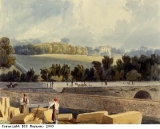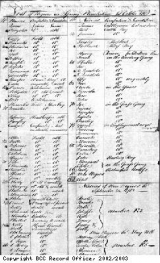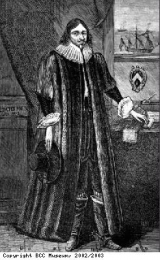Estates within 2 miles of Bristol
The Royal Fort in the Clifton area of Bristol (now owned by the University of Bristol) was built by Thomas Tyndall. It was built in about 1767 on the site of the Royal Fort precinct, which was a fort built during the English Civil War in the 1640s to protect the city. A picture of the original fort can be seen here. The Tyndall family had financial connections with the slave trade. Some members of the family were also slaving agents on Jamaica in the Caribbean for a number of Bristol merchants. Under the company name ‘Tyndalls and Ashetton’ they sold the enslaved Africans from the ships to the plantation owners in Jamaica. Before Tyndall’s house was built, the old Royal Fort buildings were inhabited throughout the late 17th and early 18th centuries. A number of people who had associations with slavery lived there during this time. One of these people was John Elbridge, who owned the Spring Plantation on the Caribbean island of Jamaica.
Arnos Court, in Brislington, south-east Bristol, and its gothic-style ‘Black Castle’ were built in the late 1750s by William Reeve. He was a Quaker (a member of a religious society known for their peaceful beliefs). He owned copper-smelting and brass-making businesses. Reeve was also a slave merchant. The Black Castle was a folly – a structure built for fun, or to enhance a view. It was built using blocks made from the waste (called slag) from his brass-making business. The slag building blocks were black, and these blocks can be seen in many buildings in and around Bristol. Reeve went bankrupt in 1775 and his house and business were sold to a member of the Tonge family, who were also important slave traders.
Ashton Court, in the south west of the city, has a long history dating back to medieval times. Its manor house was extensively renovated in the mid-eighteenth century when its owner John Hugh-Smyth married the £40,000 (worth about £2,000,000 today) heiress Rebecca Woolnough. Her wealth came partly from the Spring plantation in Jamaica, which her family owned. Pictured here is a list of the slaves on the Spring Plantation in Jamaica from 1st October, 1782. Through Rebecca, the Smyth family of Ashton Court owned a share in the plantation. The slaves, their occupation and fitness are listed. Several old women are noted as ‘useless’. The ‘New Negroes’ are noted as ‘marked Fi3’ and ‘DRS’ – they might have been branded with an identifying mark by a previous owner.
Now a private school for girls, Redland Court, in Redland, Bristol, has longstanding Caribbean connections with the slave trade. The original house was owned by Sir Robert Yeamans in the 1680s, whose portrait can be seen here. His brother, Sir John, was one of the early British settlers of the island of Barbados in the Caribbean. He was also a settler in and early Governor of South Carolina, in America. Both South Carolina and Barbados were slave colonies and had many plantations worked on by enslaved Africans. Sir John’s son, Colonel Robert Yeamans of Barbados, eventually inherited Redland Court. He then sold it in the early eighteenth century to another Barbados plantation owner, Thomas Maycock. Maycock, at his death in 1731, gave the life-time use of the house to his mistress Ann Ely, also a plantation owner. By 1738 the estate in Redland was purchased by a London grocer, John Cossins. He rebuilt the house and the nearby Redland Chapel at the time of his marriage to Martha Innys. Cossins’ new wife had inherited land in the Caribbean from her family. On the death of Cossins, she inherited Redland Court. When she died, it was left to her brothers who also inherited wealth from the Caribbean. No wonder there are African heads carved in stone on the back of Redland Chapel – the history of the building is connected with many who were linked to the slave trade.





